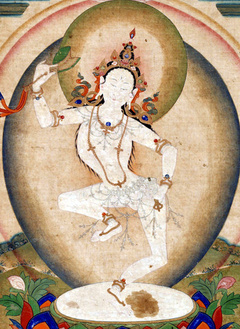Brief Biography of Gyurme Jamyang Tenpel
Brief Biography of Gyurme Jamyang Tenpel
From Supplementary Biographies for the Lineage of The Ḍākinī’s Whispered Transmission of Secret Conduct
by Jamyang Khyentse Chökyi Lodrö
Gyurme Jamyang Tenpel was born in Tramkhok Khartama in Washul. He entered the door of Dharma in the Sakya tradition, and studied with Ngor Khenchen Palden Lodrö Gyaltsen,[1] Jamyang Rinchen Dorje,[2] Wara Shabdrung Rinpoche Jamyang Namkha Gyaltsen.[3] On the Nyingma side, he received ripening empowerments, liberating instructions and experiential guidance in the Great Perfection from Dzaka Choktrul Rinpoche Kunzang Namgyal[4] and Nyoshul Lungtok Tenpai Nyima.[5] He remained at the lotus feet of Jamyang Khyentse Wangpo, in particular, for a long time. He also received boundless ripening and liberating instructions of the Sarma and Nyingma traditions from the Lord of Secrets Jamyang Loter Wangpo,[6] Ngari Chöje Kunga Jamyang,[7] and the Minyak scholar Norbu Tendzin.[8]
It was from Lord Loter Wangpo that he received the Whispered Transmission of Thangtong Gyalpo.[9] He completed the approach and accomplishment practices of many yidam deities, including Hevajra, the outer, inner and secret forms of Pañjaranātha, Sarvavid Vairocana 'Subduer of the Elemental Spirits’, and White and Green Tārā. He recited the 'Three-Oṃ' Yoginī mantra a million times, the ten-syllable Tārā mantra a hundred million times, a hundred million Maṇi mantras, a hundred million Amitābha mantras, four million Tārā,[10] and a hundred million seven-syllable Mahākāla mantras. He stayed at the great site of Pema Shelpuk ('Lotus Crystal Cave') and later in life at Tsa Chujuk, a practice place of the Great Compassionate One, and site of a hundred thousand maṇi stones first established by Khye’u Rigdzin Chenpo. On a hillside, where he had had a vision of Eleven-Faced Avalokiteśvara, he established a new temple dedicated to the deity, in which he spent the rest of his life. He practised the Profound Whispered Transmission of Thangtong Gyalpo on Demon-Severing.[11] Venerable Tārā and Pañjaranātha Mahākāla appeared to him in visions. Precious 'relics' (ringsel) arose from the point between the eyes on the mural of Eleven-Faced Avalokiteśvara in the temple. Devotees offered scarves, and in spite of the difficulty for the mural in holding them, still it received them. It thus became renowned as a blessed image. He exerted himself primarily in thematic and non-thematic practice, and to his devoted disciples he granted the empowerments, instructions and authorizations for Khecarī, the Great Compassionate One according to the Tsembu tradition, Mahākāla and so on.
In short, he was free from the constraints of the eight worldly dharmas and lived as a great renunciant and lord among yogis until, at the age of seventy-two, he passed into the realm of peace. I was the one to offer him the prompting instructions for the post-death state and to perform his cremation ceremony.[12]
| Translated by Adam Pearcey with the generous support of the Khyentse Foundation and Tertön Sogyal Trust, 2022.
Bibliography
Tibetan Editions
'jam dbyangs chos kyi blo gros. "gsang spyod mkha' 'gro'i snyan brgyud kyi brgyud pa'i rnam thar kha skong/" in gsung 'bum/_'jam dbyangs chos kyi blo gros/ (dbu med/). 8 vols. Gangtok: Dzongsar Khyentse Labrang, 1981–1985. (BDRC W21813) Vol. 6: 413–417
______. "gsang spyod mkha' 'gro'i snyan brgyud kyi brgyud pa'i rnam thar kha skong/" in 'jam dbyangs chos kyi blo gros kyi gsung 'bum. 12 vols. Bir: Khyentse Labrang, 2012. (BDRC W1KG12986). Vol. 6: 703–705
Secondary Sources
Dilgo Khyentse. The Life and Times of Jamyang Khyentse Chökyi Lodrö: The Great Biography by Dilgo Khyentse Rinpoche and Other Stories. Boulder, CO: Shambhala Publications, 2017.
Gyatso, Janet. "Genre, Authorship, and Transmission in Visionary Buddhism: The Literary Traditions of Thang-stong rGyal-po" in Steven D. Goodmand & Ronald M. Davidson (ed.). Tibetan Buddhism: Reason and Revelation. Albany, NY: State University of New York Press, 1992.
______. The Literary Transmission of the Traditions of Thang-stong rGyal-po: A Study of Visionary Buddhism in Tibet. Unpublished PhD thesis, University of California at Berkeley, 1981.
Version: 1.0-20220118
-
dpal ldan blo gros rgyal mtshan, 1840–1900. ↩
-
’jam dbyangs rin chen rdo rje, 1837–1901. ↩
-
wa ra zhabs drung nam mkha' rgyal mtshan. ↩
-
The second Dzaka Choktrul, Kunzang Namgyal (dzaH ka mchog sprul 02 kun bzang rnam rgyal, b. 19th C.). ↩
-
smyo shul lung rtogs bstan pa'i nyi ma, 1829–1901/2. ↩
-
'jam dbyangs blo gter dbang po, 1847–1914. ↩
-
mnga' ris chos rje kun dga' 'jam dbyangs. ↩
-
Reading me nyag as mi nyag. This refers to Minyak Rongsharwa Tupten Lekshé Zangpo (mi nyag rong shar ba thub bstan legs bshad bzang po, b. 1835) or Tsokshul Lama (tshogs shul bla ma), who is also known as Saché Lama (sa bcad bla ma), because he proposed dispensing with the final, post-suffix (yang 'jug) sa of Tibetan orthography. ↩
-
On this tradition see Gyatso 1981, pp. 160–185. ↩
-
It is unclear precisely what is referred to here since Tārā’s ten-syllable mantra has already been mentioned above. ↩
-
The Tibetan here is obscure: sa ru lugs la 'brel 'jog = combined with the Saru (?) tradition. ↩
-
The text continues with Jamyang Khyentse’s own autobiography: https://www.lotsawahouse.org/tibetan-masters/jamyang-khyentse-chokyi-lodro/short-autobiography. ↩
